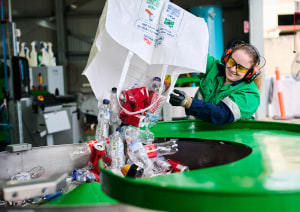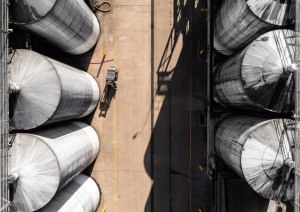While many companies approach coding and labelling as a necessary chore of the packaging process, Amcor Beverages’ business in Australia has found that necessity can also be recruited as a branding tool.
Indeed, at a time when social media is becoming an ever-more pervasive aspect of every day life for consumers, the company has leveraged its expertise in printing and coding technologies to tap into emerging digital consumer trends.
Group general manager for Amcor Beverages, Brian Lowe, says the innovative use of coding tools can present some surprising opportunities for brand owners to help their products stand out from competitors.
“Amcor produces a lot of different packaging types across a lot of formats and we are always keen to make sure we are up to date and connected with the trends and the latest technologies such as the ever increasing use of smartphones and social media,”
Lowe tells PKN. “Certainly it has been a focus area of late for the company. That will only increase as we go forward.”
A number of recent projects undertaken in the wine industry, he says, demonstrate how coding can play a role beyond its usual “track and trace” function.
“We always want to know what we can add to help customers brand their products,” he says. “So lately we have been looking at how we can go about using certain codes, like quick response (QR) codes, putting them on products and closures, and how we can use these to help with customer branding.”
One such recent project was undertaken on behalf of Lark Hill Winery, a specialist in biodynamic wines, based outside Canberra.
In what Lowe says is a first for the Australian market, Amcor produced closures for the vinter's wine range, incorporating QR codes, those matrix barcode designs that have become a common site in many contemporary marketing and advertising campaigns.
As Lowe explains, the winery and the packaging giant investigated how QR codes could be incorporated onto the packaging of wines to offer a way for smart and connected consumers to personally engage with the product, without compromising the ability to use the full label real estate for branding.
The solution, he says, was to incorporate the QR codes on the wines' screw top labels.
“The trend of using screw caps to close wine bottles and keep it fresher for a longer time after opening has been going on for some time now,” he says. “Considering we supply a lot of the glass bottles and closures for the wine industry, we had been investigating ways to innovate in this area for some time. One idea involved the coding.
“The barcode is the oldest and simplest version of digital coding to date, but now we are seeing things like radio frequency identification (RFID) and QR codes coming through, so it’s been important for us to consider how those segments will develop in the future.
“We had been tossing around ideas about what applications of such codes we could make work and Lark Hill came to us for advice on how we could use technology on bottles and caps and that gave us some impetus to take our ideas further.”
While it may at first seem a simple task to print a code on the top of a screw cap closure, Lowe said there were a number of technical hurdles to be mounted first.
“We had to uphold strict quality assurance (QA) standards in producing this screw-cap, particularly in terms of registration and print clarity, in order to ensure the QR codes scanned effectively,” he says. “Quite simply, it had to be readable and the print quality had to be high enough to ensure it could be scanned and read properly through automated systems.”
Introduced onto the market earlier this year, the screw caps for the Lark Hill wines at their most basic level provide a medium for the consumer to actively engage with the product. “You can scan the QR code, get taken to their web site, and get more information about the wine, rather than having to print all that information on the label,” Lowe says.
“It leaves space to do more with the design of the label itself, but if you look at where this may go in the future, you can see applications like going into a store, scanning a QR code from the cap on your smartphone, and getting complete information about the product, as well as things like tasting notes, cuisine recommendations, consumption and health information and more – in other words, much more information than you would ever be able to put on the label.”
Lowe says the QR code application also has the potential to go beyond mere branding and consumer engagement.
“At this point, it is marketing focused, but coding in itself will certainly play a bigger part in packaging going forward,” he says. “In the wine and beverages industry, for example, there is also the question of authenticity, how we can make sure a product being exported and sold overseas is the right product and not a copy or a counterfeit.
“This sort of thing can really help with that by digitally verifying a bottle's authenticity.
“In other words, when you open up a bottle of Lark Hill wine in China or in Europe, the code on the cap will direct you back to the same website, verifying it as a real Lark Hill product.”
Across the Tasman, another project by Amcor Beverages on behalf of Brancott Estate wines has demonstrated how coding can be put to use to ensure proper and effective shelf display of bottles – using ultra violet (UV) ink.
The task in that case was to produce a mark or mechanism on the winery's bottles to ensure they were placed on a shelf in proper alignment, with the label clearly and easily visible to the consumer.
“The technology for orientation is not new, but what has been done historically is to use visible markers as a cue to orientate something,” Lowe explains, “but that impacts on how you can use your package to enhance the look and shelf appeal and again it takes away space that could be used more for branding.”
Starting earlier this year with Brancott Estate's Pernod Ricard product, Amcor developed a system whereby UV ink could be printed on the cap for registration.
“Having a screw cap facing in the right direction may not seem earth shattering, but it certainly makes a difference in terms of shelf impact and [consumer product] recall,” Lowe says. “The concept of using UV inks, which are invisible to the naked eye but can be detected and registered by the right sort of equipment, has been toyed with for quite a while, but our work for Brancott means they are the only ones using it to date.
“The reason it's happening now is that we did a lot of work with the sensing systems and equipment to ensure the UV code could be read consistently and accurately,” says Lowe. “This meant we had to get the printing correct in terms of intensity, the right type of UV ink, and linking that works with the right type of sensing technology.”
The result is a technique whereby the Amcor technology enables the screw-cap branding to be orientated to the front of the bottle via an invisible printed UV strip, which is registered by a detection device during the capping process.
The innovation provides a uniform brand identity, and assists in shelf differentiation.






